
In its search for immortality, Google hopes to cure death. Can technology radically alter the fabric of our existence? Google believes, it can. The Internet giant’s healthcare and sci-fi projects aim to cure the most dangerous diseases, extend your age, and achieve eternal life. Here’s how Google wants you to live forever:
Detecting & Fighting Cancer Within The Body
In order to detect very early signs of heart attacks or strokes, cancer and other life threatening diseases before they become untreatable and fatal, Google is developing a pill containing nanoparticles – approximately 10,000 times smaller than the width of a human hair – that enter a patient’s bloodstream, detect the presence of biomarker molecules inside the body, and transmit the information using a wrist-worn sensor.
Andrew Conrad, Google’s head of life sciences, explains:
“Essentially the idea is simple; you just swallow a pill with the nanoparticles, which are decorated with antibodies or molecules that detect other molecules. They course through your body and because the cores of these particles are magnetic, you can call them somewhere and ask them what they saw. We ask them: Hey, what did you see? Did you find cancer? Did you see something that looks like a fragile plaque for a heart attack? Did you see too much sodium?”
The idea is to identify slight changes in the person’s biochemistry that could act as an early warning system, Andrew told the BBC.
“What we are trying to do is change medicine from reactive and transactional to proactive and preventative. Nanoparticles give you the ability to explore the body at a molecular and cellular level.”
In July 2014, Google announced the Baseline Study with Duke University and Stanford University to investigate and map how the human body behaves when it’s healthy, detect changes and catch life-threatening illnesses much earlier to either diminish the impact or neutralize the condition before symptoms appear.
Preventing Aging, Extending Life Expectancy
Bill Maris, the Chief Executive Officer of Alphabet’s early-stage investment arm, Google Ventures, told The Wall Street Journal in 2012: “I’m interested in the ideas that sound a little crazy, such as radical life extension, curing cancer, being able to create a simulation of the human brain and map every neuron”.
In September 2013, Google created Calico to “reverse engineer the biology that controls lifespan and devise interventions that enable people to lead longer and healthier lives”. Thanking Bill for helping bring this idea to life, and appointing Art Levinson as Calico’s Chief Executive Officer, Larry Page announced:
“Art and I are excited about tackling aging and illness. These issues affect us all—from the decreased mobility and mental agility that comes with age, to life-threatening diseases that exact a terrible physical and emotional toll on individuals and families. And while this is clearly a longer-term bet, we believe we can make good progress within reasonable timescales with the right goals and the right people.”
In September 2014, Calico, 2M Companies and the University of Texas’s Southwestern Medical Center formed a partnership to advance drug development and research for neurodegenerative diseases that come with aging and the death of nerve cells, such as Alzheimer’s and Parkinson’s. The same month, Calico inked a $1.5 billion, 10-year research and commercialization deal with US drug maker AbbVie Inc to develop treatments for Parkinson’s and Lou Gehrig’s disease, as well as treat traumatic brain injury.
A couple of months later, Google launched Liftware Spoon to allow Parkinson’s patients to manage hand tremors and eat without spilling. The Spoon uses hundreds of algorithms to sense how a hand is shaking and makes instant adjustments to stay balanced.
Monitoring Blood Sugar Levels In Diabetics
In 2014, Google tested a glucose measuring contact lens that used a tiny embedded glucose sensor and wireless chip to measure glucose levels in tears for patients with diabetes. Brian Otis and Parviz, co-founders of the project, said two years ago:
“We’re testing prototypes that can generate a reading once per second. We’re also investigating the potential for this to serve as an early warning for the wearer, so we’re exploring integrating tiny LED lights that could light up to indicate that glucose levels have crossed above or below certain thresholds.”
In October 2015, the tech giant was awarded a patent for a solar-powered contact lens capable of communicating with computers, collecting wearer’s biological data, including internal body temperature and blood-alcohol content, and sensing allergens like grass or tree pollen, pet dander, and dust mite excretions.
Slowing Down Multiple Sclerosis Progression
In January 2015, Google teamed up with multiple sclerosis drug maker Biogen Inc to study environmental and biological contributors to multiple sclerosis and why the debilitating disease progresses differently in different patients. Andrew told Bloomberg:
“Our central thesis is to change health care from being reactive to proactive. We’re trying to understand disease at its onset and see if we can intervene early.”
This Article (How Google Is Trying To Cure Cancer, Stop Aging, & Defy Death) is free and open source. You have permission to republish this article under a Creative Commons license with attribution to the author and AnonHQ.com.







Old story